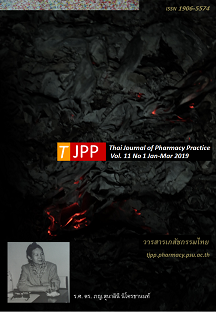การศึกษาเบื้องต้นถึงประสิทธิภาพและความปลอดภัยของยาแคปซูลประสะไพลสกัด ในการบรรเทาอาการปวดแบบเฉียบพลันที่มีสาเหตุจากการบาดเจ็บของกล้ามเนื้อ
Main Article Content
บทคัดย่อ
วัตถุประสงค์: เพื่อศึกษาประสิทธิภาพ และความปลอดภัยของประสะไพลสกัด ในการบรรเทาอาการปวดที่มีสาเหตุจากการบาดเจ็บของกล้ามเนื้อแบบเฉียบพลัน วิธีการ: การศึกษานำร่องในครั้งนี้เป็นการทดลองทางคลินิกแบบสุ่มที่มีกลุ่มควบคุมและปกปิด 2 ด้านในผู้ป่วย 148 คนที่มีอายุ 20-45 ปีและมีอาการปวดจากการบาดเจ็บของกล้ามเนื้อแบบเฉียบพลันในระดับ 3 คะแนนขึ้นไป ผู้ป่วยถูกสุ่มด้วยโปรแกรมคอมพิวเตอร์เพื่อแบ่งเป็น 2 กลุ่ม กลุ่มละ 74 คน ผู้ป่วยได้รับยาแคปซูลประสะไพลสกัด 250 มิลลิกรัม 2 แคปซูล ก่อนอาหาร 3 เวลา ร่วมกับยาหลอกไดโคลฟีแนค หรือรับประทานยาไดโคลฟีแนค 25 มิลลิกรัม 1 เม็ด หลังอาหาร 3 เวลา ร่วมกับยาหลอกประสะไพล เป็นเวลา 7 วัน การศึกษาประเมินระดับความปวด ลักษณะการปวด และเหตุการณ์ไม่พึงประสงค์ที่ 6 ชั่วโมง และ 7 วัน หลังเริ่มรับประทานยา รวมทั้งประเมินค่าการทำงานของตับและไตด้วยการตรวจทางห้องปฏิบัติการ ผลการวิจัย: หลังใช้ยา 7 วัน สัดส่วนผู้ป่วยที่มีอาการปวดดีขึ้นของทั้งสองกลุ่มไม่ต่างกัน (ความแตกต่างระหว่างกลุ่ม คือ -0.01, 95%CI: -0.17, 0.15) แต่ระดับการปวดของทั้งสองกลุ่มลดลงจากก่อนรับประทานยาอย่างมีนัยสำคัญทางสถิติ (P<0.05) และนัยสำคัญทางคลินิก โดยความปวดลดลงร้อยละ 67.73 (95%CI: 59.59, 75.87) ในกลุ่มประสะไพล และร้อยละ 68.48 (95%CI:61.23-75.74) ในกลุ่มไดโคลฟีแนค การศึกษาไม่พบเหตุการณ์ไม่พึงประสงค์ที่รุนแรง แต่พบเหตุการณ์ไม่พึงประสงค์แบบเล็กน้อยทั้งสองกลุ่ม ผู้ป่วยในกลุ่มประสะไพลมีผื่นแดงและคัน อย่างละ 1 ราย กลุ่มไดโคลฟีแนคมีหน้าบวมและตาบวม อย่างละ 1 ราย ค่าการทำงานของตับและไตของทั้งสองกลุ่มไม่แตกต่างกัน สรุป: การศึกษาเบื้องต้นบ่งชี้ว่า ยาประสะไพลมีประสิทธิภาพไม่ด้อยไปกว่ายาเม็ดไดโคลฟีแนคในการบรรเทาอาการปวดกล้ามเนื้อแบบเฉียบพลัน และมีความปลอดภัยในการใช้ระยะสั้น อย่างไรก็ตามควรมีการศึกษาผลของยาในผู้ป่วยจำนวนมากในระยะยาวเพิ่มเติม
Article Details
ผลการวิจัยและความคิดเห็นที่ปรากฏในบทความถือเป็นความคิดเห็นและอยู่ในความรับผิดชอบของผู้นิพนธ์ มิใช่ความเห็นหรือความรับผิดชอบของกองบรรณาธิการ หรือคณะเภสัชศาสตร์ มหาวิทยาลัยสงขลานครินทร์ ทั้งนี้ไม่รวมความผิดพลาดอันเกิดจากการพิมพ์ บทความที่ได้รับการเผยแพร่โดยวารสารเภสัชกรรมไทยถือเป็นสิทธิ์ของวารสารฯ
เอกสารอ้างอิง
2. Bernard BP. a Work-related musculoskeletal disorders and psychosocial factors. In, Musculoskeletal disorders and workplace factors: A critical review of epidemiologic evidence for work-related musculoske letal disorders of the neck, upper extremity, and low back. Cincinnati, US. Department of Health and Human Services, National Institute of Occupational Safety and Health. 1997.
3. Donpunha W, Puntumetakul R, Amatachaya S. Prevalence of musculoskeletal disorders in farmers: Case study in Sila, Muang Khon Kaen, Khon Kaen province. J Med Tech Phy Ther 2009; 21:153-9.
4. Janwantanakul P, Pensri P, Jiamjarasrangsri V, Sinsongsook T. Prevalence of self-reported musculo skeletal symptoms among office workers. Occup Med 2008; 58:436–8.
5. Chuprapawan J. An evaluation of the national health examination survey in Thailand. Bangkok. Health Systems Research Institute 1996; 1:95-100.
6. Morken T, Riise T, Moen B, Bergum O, Vigeland Huage S.H., Holien S et al. Frequent musculoskeletal symptoms and reduced health-related quality of life among industrial workers. Occup Med 2002; 52:91-98.
7. Sungkhabut W, Chaiklieng S. Prevalence of Musculoskeletal Disorders among informal sector workers of hand-operated rebar bender in non-sung district of Nakhon Ratchasima Province. KKU Research Journal 2011; 26: 225-32.
8. Janwantanakul P, Pensri P, Jiamjarasrangsi W, Moonkay P. Final report: Screening test and health promotion program for treatment of musculoskeletal symptoms in the neck and low back in office workers. Bangkok. Thai Health Promotion Foundation; 2010.
9. Janwantanakul P, Pensri P, Sinsongsook T, Jiamjarasrangsi W, Supakankunti S. Prevalence, contributing factors and economic loss work-related musculoskeletal symptoms among office workers in company in Bangkok metropolis area. Bangkok. Social Security Office. 2006.
10. National Statistical Office. The population survey of work condition [online]. 2009. [cited Apr 26, 2014]. Available from: service.nso.go.th/nso/nsopublish/ser vice/lfs52/ reportJan.pdf.
11. Thienthong S. Clinical guidance for acute pain management. Bangkok: Thai Association for the Study of Pain; 2009.
12. Korsuntirat T. Non-steroidal anti-inflammatory drugs [editorial]. J Med Health Sci 2010; 17: 97-113.
13. National List of Essential Medicines (herb). Royal Gazette No.130, part 126 (Aug 7, 2013).
14. Subcommittee on the Preparation of Monographs of Selected Thai Materia Medica. Monograph of selected thai materia medica: Phlai. Journal of Thai Traditional and Alternative Medicine 2012; 10: 52-6.
15. Panichayupakaranant P, Lateh L. Zingiber cassumu nar: Chemical composition, pharmacological activities, toxicology and quality control. Journal of Thai Traditional and Alternative Medicine 2013; 11: 123-35.
16. Boonyen M. Study on formulation and stability test of prasaplai extract tablets and capsules for dysmennorhea [master thesis]. Bankok: Thammasart University; 2001.
17. Nualkaew S. Phytochemical and pharmacological studies of a Thai traditional preparation: Prasaplai [master thesis]. Bankok: Mahidol University; 2004.
18. Sasum S. The development of prasaplai capsule extract and efficacy for relieving primary dysmenor rheal [dissertation]. Mahasarakham; Mahasarakham University; 2010.
19. Kamalashiran C, Lekskulchai O. The comparative study of the efficacy and side effect of prasaplai extract versus mefenamic acid on relieving primary dysmenorrhea: A clinical phase II trials. Thammasat Medical Journal 2012; 12: 749-56.
20. Ittharat A, et al. The report of efficacy and safety of prasaplai for using in obstetrics and gynecology. Bankok: Thammasat University; 2009.
21. Musculoskeletal System and Connective Iissue. In: International statistical classification of diseases and related health problems Thai modification. 10th ed. Ministry of Public Health. Nontaburi 2012; p 403-10.
22. Kitisomprayoonkul W, Klaphajone J, Kovindha A. Thai short-form McGill pain questionnaire. J Med Assoc Thai 2006; 89: 846-53.
23. Sawangjit R, Chokpraisin R, Tiyaboonchai W, Lamlertthon S, et al. Topical product containing long pepper extract on muscle pain relief. Final report (in Thai), Department of Medical Sciences, Ministry of Public Health; 2013.
24. Jones P, Dalziel SR, Lamdin R, Miles-Chan JL, Frampton C. Oral non-steroidal anti-inflammatory drugs versus other oral analgesic agents for acute soft tissue injury. Cochrane Database of Systematic Reviews 2015; 7(CD007789). DOI: 10.1002/1465185 8.CD007789.pub2.
25. Drugs used in musculoskeletal and joints. In: Sawetsila S, Likitthanaset M, Hongthong S, editors. Green book 10. Ministry of Public Health. National Office of Buddhism. Nontaburi; 2014.
26. Chakchai K. Formulation and satisfaction assessment of prasaplai in primary dysmenorrhea patients at primary care center: Mahasarakham University [dissertation]. Mahasarakham; Mahasarakham University; 2008.
27. Archananuphap S. Diclofenac. In: Archananuphap S, editors. Textbook of general diagnosis. 4th ed. Holistic publishing. Bangkok 2008, p 232-33.


